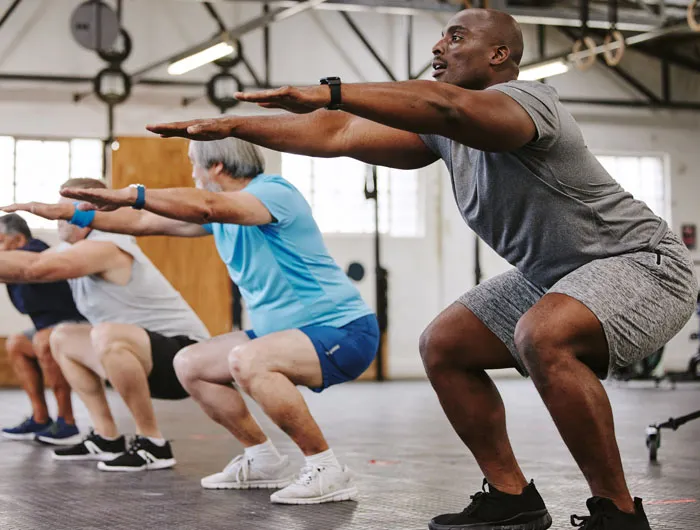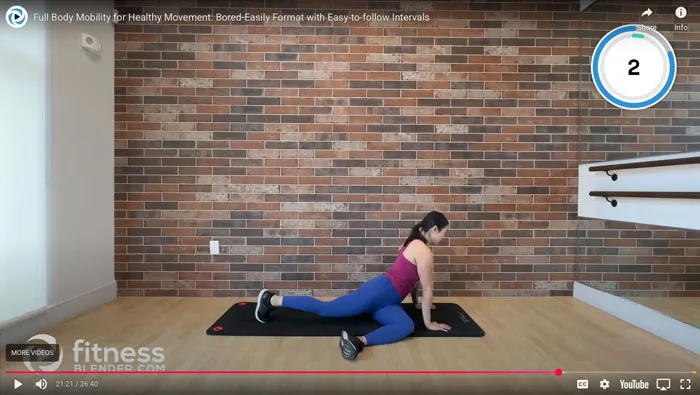Why you should try to improve your mobility

Siphosethu F - stock.adobe.com.
We know. First, you were told to do aerobic exercise most days of the week. Then, they said you needed to do muscle-building moves at least twice a week. And now we’re saying you need to also work on your mobility. But hear us out: You just need about 5 minutes a day, and the bang is well worth the buck.
What is mobility?
Mobility is the range of motion a joint has while you’re actively moving it. It’s the ability to move freely. Flexibility, on the other hand, typically refers to the muscles, ligaments, and tendons passively stretching (like bending over to touch your toes to stretch your hamstrings). As one expert put it, “mobility requires flexibility, but flexibility does not always require mobility.”
What activities can improve mobility?
“If you move, you’ll increase your range of motion,” says David Behm, a professor in the School of Human Kinetics and Recreation at the Memorial University of Newfoundland in Canada. But not all movement increases range of motion equally.
Walking. “If you got up and you walked around the block a couple of times, you would improve your range of motion,” says Behm. Why? Moving your muscles builds heat. “And if you add heat to a tissue, you reduce the tissue’s viscosity.” And less viscosity means more pliable muscles.
“Walking increases range of motion because you’re warmed up, but not to the same extent as stretching, resistance training, or foam rolling.”
Stretching. “For the last 100 years or so, stretching has been the go-to exercise for increasing range of motion,” says Behm. There’s no question that stretching works. That said, there is evidence that if you stretch a muscle for longer than 60 seconds, it could moderately impair performance. But since most of us are unlikely to stretch a muscle for that long—and assuming we’re not professional athletes—there’s no reason to avoid stretching.
Stretching has other benefits. “Stretching seems to decrease injury if you're doing high-speed movements like sprinting or changing direction,” says Behm. You might do those types of movements in sports like soccer, tennis, hockey, basketball, or dancing.
“But it’s not going to prevent overuse injuries for people who, say, go out for runs regularly,” says Behm.
While it may come as no surprise that stretching improves range of motion, Behm has uncovered other fascinating effects of stretching. In his team’s research and analyses of others’ research, “we've seen that when you stretch one hamstring, the other hamstring becomes more flexible. Or you stretch your shoulders, and your hamstrings become more flexible.”
Why? “Go back to that pain threshold mechanism,” says Behm. “If I stretch my hamstrings to a point of discomfort and hold it long enough, I'll be able to have a greater pain threshold. So then when I go and stretch my shoulders, I can push myself farther than I did before.”
Does stretching your hamstring improve your shoulder’s range of motion as much as just stretching your shoulder? “The effect is similar,” says Behm.
How long you hold the stretch might matter. In one of Behm’s analyses, stretching had the biggest impact on the mobility of other joints when people held their stretches for a long time, on the order of two to four minutes. (Concerned about stretching impairing your exercise performance? It only matters if you do it before you perform athletics. Even then, the impairment is small.)
The bottom line: Stretch your body regularly, but don’t worry too much about which muscles you focus on. Mix it up and your whole body will benefit.
Strength training. “In a recent analysis of 55 trials, we showed that resistance training can increase range of motion to the same extent as stretching,” says Behm. Using either free weights or machines or doing Pilates all improved range of motion.
Interestingly, adding stretching to the resistance training routine didn’t give a bigger boost in range of motion. “I’m 68, and for the last 50 years, I have always stretched before I lifted weights,” says Behm. “But it turns out that I don't really need to.” (It’s still a good idea to do a warmup to get your muscles warm before you stress them. You just don’t need to stretch as part of your warmup.)
Why not? “Same as walking, you get decreased muscle viscosity when you do strength training because it generates heat,” Behm explains. “And you add stress to the muscle, which also reduces viscosity.”
Strength training has another advantage, one it shares with stretching. “You tend to have a greater range of motion when the stretch threshold, or the pain threshold, increases,” says Behm. “So if I stretch or I lift weights and feel uncomfortable, then I will get used to that discomfort and realize I'm not going to hurt myself, so I can push myself farther. And then I might release some endorphins or enkephalins, which are morphine-like substances, and they also help to decrease pain.”
Both strength training and stretching that lead to discomfort are good things. The next time you stretch or lift weights (assuming you don’t go more than about a week between sessions), “you'll be able to push yourself farther, because you have that higher pain threshold,” says Behm.
Foam rolling. According to another analysis by Behm’s team, “using foam rollers increases range of motion, at least during a single session, to a similar extent as stretching,” he notes. You’ll get the most bang for your buck by foam rolling the larger muscles like your hamstrings (in the back of your thighs) and quadriceps (in the front of your thighs). But Behm suspects that joints with more limited range of motion like the ankle or those with a prior history of injury like sprains may be less receptive to foam rolling.

Why does mobility matter?
“You need mobility for so many things in life,” says Behm. “If you want to bend down to tie your shoes, you need some joint mobility.”
“But you don’t need to be a gymnast,” he points out. “There are people out there who say, ‘I can teach you how to do the splits.’ We don’t need to do the splits. You’re not going to be any healthier if you can do the splits, but you do need mobility for activities of daily living.”
“And for older people, one of the biggest problems are trips, slips, and falls,” adds Behm. “If you have a very limited range of motion, when you trip or slip, you can’t reach your leg out as far to rebalance yourself. Your base of support is much smaller, so you’re more likely to fall over if you don’t have good range of motion.”
But mobility doesn’t just matter for tying your shoes or preventing a fall. It also improves your exercise performance. “If you’re a golfer, you can hit the ball farther if you have a greater swing arc,” says Behm. “If you’re a tennis player, your serve will be faster if you have a greater range of motion.” Struggling to get into a deep squat when you’re weightlifting? You may need to work on mobility in your ankles or hips.
Should you add mobility-focused exercises to your routine?
Not thrilled about adding yet another activity to your workout? Don’t worry.
“It only takes about five minutes to add mobility exercises,” says Behm. “I’m an old guy, but I still play tennis and hockey. Because I’m already very active, I don’t need to do a lot of extra mobility work. I just do some warmup exercises before I get on the tennis court or the ice arena.”
“Working on mobility is important for younger and older people to do on a regular basis,” he adds. “But if you’re already very active, you don't need to do a lot.”
The opposite is also true. “If going on walks is someone’s only exercise, they’re not getting much range of motion,” says Behm. “It’s better than nothing, but they should put a greater emphasis on doing these mobility exercises.”
What to do
Get moving. Stretch, lift weights, foam roll, dance, play pickleball, jog, walk. All will improve your mobility (to varying degrees). The more you do, the less you need to focus on adding mobility-specific exercises to your routine.
Not sure where to get started? Search for mobility exercise workouts on YouTube or check out routines from Silver Sneakers or FitnessBlender.
Support CSPI today
As a nonprofit organization that takes no donations from industry or government, CSPI relies on the support of donors to continue our work in securing a safe, nutritious, and transparent food system. Every donation—no matter how small—helps CSPI continue improving food access, removing harmful additives, strengthening food safety, conducting and reviewing research, and reforming food labeling.
Please support CSPI today, and consider contributing monthly. Thank you.
Our best (free) healthy tips
Our free Healthy Tips newsletter offers a peek at what Nutrition Action subscribers get—scrupulously researched advice about foods, ingredients, and supplements of all kinds, plus staying healthy, exercise, and more.

